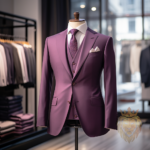A well-tailored suit is more than just clothing—it’s a statement. Whether you’re heading to the office, attending a wedding, or stepping out for a special event, the right suit can boost your confidence, enhance your appearance, and leave a lasting impression. This guide will walk you through everything you need to know about choosing, styling, and accessorizing suits for different occasions and body types, ensuring you always look sharp and sophisticated.
1. Choosing the Right Suit for Your Body Type
The key to looking great in a suit is finding one that complements your body type. Here’s how to choose a suit that fits perfectly:
Athletic Build: If you have broad shoulders and a slim waist, opt for a suit that accentuates your V-shape. Look for jackets with a structured shoulder and a tapered waist. Slim-fit trousers will complement your physique without being too tight.
Slim Build: For a lean frame, a slim-fit suit is ideal. It adds structure and enhances your silhouette. Consider a double-breasted jacket to create the illusion of a broader chest.
Broad Build: If you have a larger build, look for suits with a relaxed fit that provide comfort and structure without adding bulk. Dark colors like navy or charcoal gray can create a slimming effect.
Tall Build: Taller men should opt for suits with a bit of length in the jacket to balance their height. Patterns like checks or plaids can break up the length and add visual interest.
Short Build: Shorter men should choose a suit that elongates their frame. A single-breasted jacket with narrow lapels and slim-fit trousers will create a sleek, streamlined look.
2. The Essentials of Suit Fabric
The fabric of your suit is crucial to its appearance, comfort, and durability. Here are some common fabrics and their benefits:
Wool: The most popular choice for suits, wool is versatile, durable, and available in various weights. It’s perfect for year-round wear.
Cotton: A breathable option, cotton suits are great for warmer months or more casual settings. However, they tend to wrinkle easily, so they may require more maintenance.
Linen: Ideal for summer, linen suits are lightweight and breathable. However, linen is prone to wrinkling, giving it a more relaxed, casual vibe.
Tweed: A heavier fabric, tweed is perfect for colder months. It offers texture and warmth, making it a great choice for fall and winter events.
Polyester Blends: Suits made from polyester blends are more affordable and resistant to wrinkles but may lack the breathability and luxury of natural fabrics.
3. Mastering Suit Colors and Patterns
Choosing the right color and pattern for your suit is essential to creating the perfect look:
Navy Blue: A versatile and classic choice, navy suits work for almost any occasion, from business meetings to weddings.
Charcoal Gray: Another versatile option, charcoal gray suits are perfect for formal events and can be easily paired with various shirt and tie combinations.
Black: Ideal for evening events or formal occasions, black suits are sleek and timeless. However, they can be too harsh for daytime events.
Light Gray: A great choice for spring and summer, light gray suits are stylish and modern, offering a fresh alternative to darker tones.
Patterns: Pinstripes, checks, and plaids add personality to your suit. Pinstripes are perfect for the office, while checks and plaids are great for casual or creative environments.
4. The Importance of Fit: Tailoring Tips
No matter how expensive your suit is, if it doesn’t fit well, it won’t look good. Here are some tailoring tips to ensure your suit fits perfectly:
Shoulders: The jacket should fit snugly on your shoulders without any overhang. If the shoulders don’t fit, it’s difficult to alter.
Jacket Length: The jacket should cover your seat and fall naturally. The sleeves should end at your wrist bone, allowing a half-inch of your shirt cuff to show.
Trousers: The trousers should sit at your waist, not your hips. The length should be just right—touching the top of your shoes with a slight break.
Tailoring: Don’t hesitate to visit a tailor to get your suit adjusted. A few tweaks can make a world of difference in how your suit looks and feels.
5. Accessorizing Your Suit
Accessories can elevate your suit game from good to great. Here are some must-have accessories to consider:
Ties: A tie is a classic accessory that can add color and personality to your suit. Choose silk ties for a polished look, and don’t be afraid to experiment with patterns and textures.
Pocket Squares: A pocket square adds a touch of elegance to your outfit. It should complement your tie without matching it exactly.
Watches: A classic watch is the perfect finishing touch for any suit. Opt for a leather strap for a more traditional look or a metal band for a modern touch.
Cufflinks: Cufflinks are essential for French-cuff shirts, adding a sophisticated touch to your look. Choose a style that reflects your personality.
Belts and Shoes: Your belt should match your shoes in color and material. Black leather for formal occasions, and brown leather for more casual events.
6. Styling Suits for Different Occasions
How you style your suit depends on the occasion. Here are some tips for different settings:
Business: For a professional look, stick to classic colors like navy, charcoal, or gray. Pair your suit with a crisp white or light blue shirt and a conservative tie.
Weddings: Depending on the wedding’s formality, you can opt for a classic black tuxedo or a lighter-colored suit. Add a boutonniere and consider a bow tie for a more formal look.
Casual Events: For a smart-casual look, try a blazer with chinos or jeans. You can skip the tie and wear a more relaxed shirt, such as a polo or a dress shirt with an open collar.
Church: A suit for church should be respectful yet stylish. Navy or gray suits work well, paired with a light-colored shirt and a tie that isn’t too flashy.
7. Caring for Your Suit
Proper care extends the life of your suit and keeps it looking sharp:
Dry Cleaning: Only dry clean your suit when necessary, as excessive dry cleaning can damage the fabric. Spot clean minor stains and use a fabric brush to remove lint and dust.
Storage: Store your suit on a good quality hanger to maintain its shape. Use a garment bag to protect it from dust and light.
Ironing and Steaming: Use a steamer to remove wrinkles without damaging the fabric. If you need to iron, use a cloth between the iron and the suit to prevent shine.
A well-fitted suit is an investment in your style and confidence. By understanding your body type, choosing the right fabric, mastering fit and tailoring, and carefully selecting accessories, you can elevate your look for any occasion. Remember, the suit doesn’t make the man—the man makes the suit. Wear it with confidence, and you’ll always make a strong impression.







































